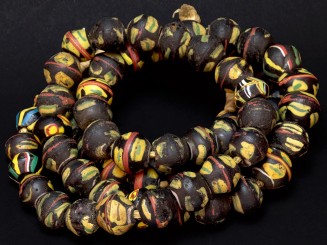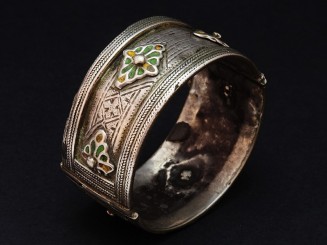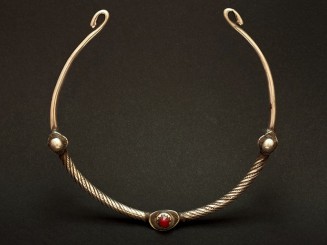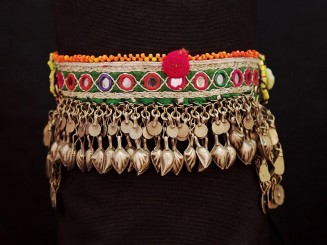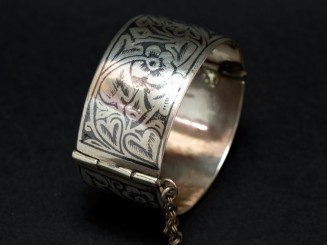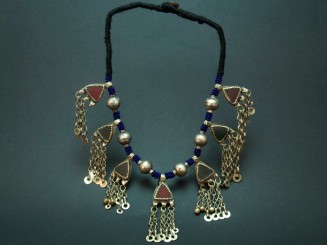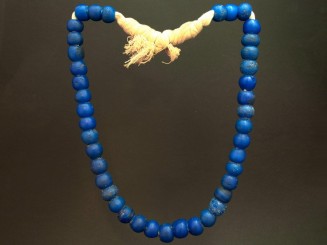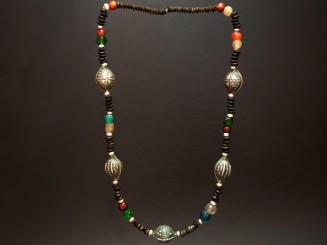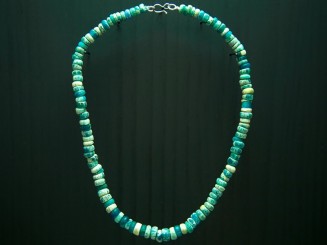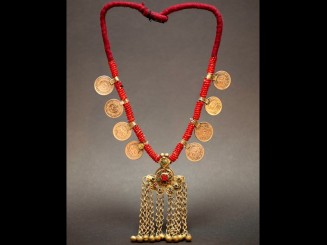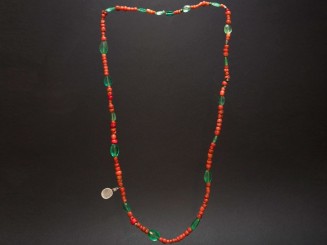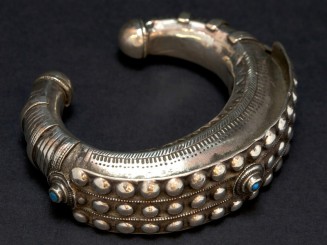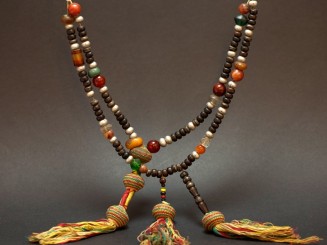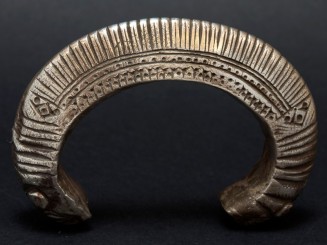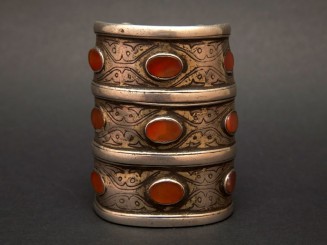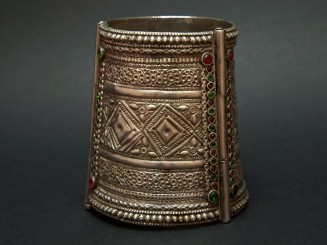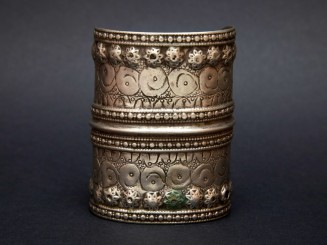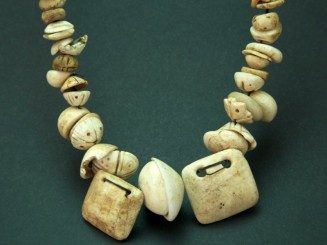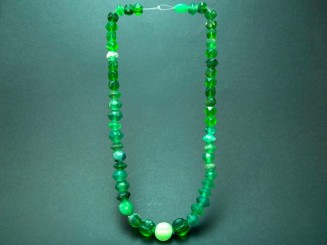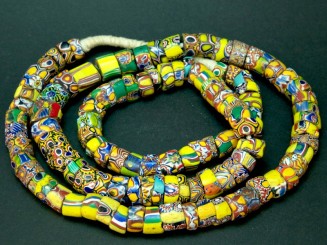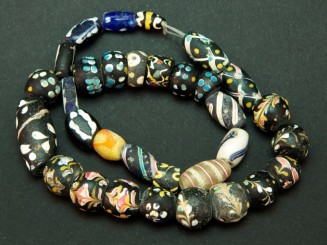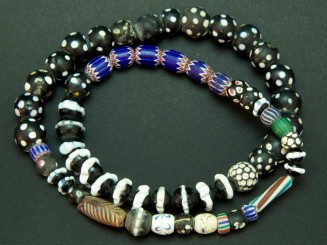
Jewels
-
Price €105.00BC0417-040
A very original Mauritanian vintage and old glass, stone and resin beads necklace. Mauritania’s fascination for beads has in this colorful necklace a good example. Venice and Bohemia glass trade beads, outstanding the four small Chevrons. Four beautiful rhomboidal “African amber” resin larger beads, and the triangular central pendant, a most probably Czech imitation in glass of the Idar-Oberstain carnelians.
The triangular central pendant measures 26x27mm
-
Price €265.00AC0616-638
A superb strand of sixty eight trade glass biconical beads, most of them are “eye beads” inspired on the much more ancient Islamic type, and five of them with linear decoration are the so called “King beads” by English merchants or Gololo by West Africans. These types of beads were made in Venice as from the beginning of the XIXth century using the lamp work technique. They were made in a variety of colors combining an opaque glass, solid color core (yellow, burgundy, black, green, etc.). These beads were among the most important ones in the gold trade in Africa.
The biggest bead is 16mm long and 23mm diameter and the smallest 10mm by 12mm.
We use the term trade beads to refer to the European made glass beads that were used by the European merchants and explorers in the trade in Africa as from the 15th century and continued during their colonial expansion. The history of trade beads in Africa takes us then to the 15th century and the arrival of the European, mainly the Portuguese, to the coasts of West Africa. The European discovered quite soon how much the people they met there fancied beads and saw they an opportunity for trade. Amongst the beads that captivated the African people most were glass beads since the techniques for their making had not yet been developed locally. The locals fell for the precious and colorful glass beads such as Venetian millefiori or chevron beads that the European traders had on offer and bartered them for commodities such as precious woods, ivory, gold and even used, ignominiously, in the slave trade. The increasing demand in Africa of European made glass beads continued quite until the first half of the 20th century and it had a boosting effect in the production in cities such as Venice which glass beads became very popular and coveted.
Lamp working is one of the main techniques for the making of glass beads. Lamp or lamp work beads were made using glass canes that were reheated to a temperature of up to 1000 ºC by means of a blowtorch or blowlamp and which were then wound onto a coated iron rod to avoid the molten glass from sticking to the metal. The beads produced by the artisan by these means could be then further decorated by re-heating the bead using the same lamp work method and applying colored glass rods or glass cane inserts to the surface of the bead creating an endless variation of patterns and making of each bead one of its own.
-
Price €265.00AC0616-637
Lovely strand of fifty seven trade glass biconical beads. These type of beads were made in Venice as from the beginning of the XIXth century using the lamp work technique. They were made in a variety of colors combining a opaque glass solid color core (yellow, burgundy, black, green, etc) on which linear decoration was applied in a lively combination of colors. These beads were known in the trade a “King beads” and also, locally, as Gololo beads. These beads were among the most important ones in the gold trade in Africa.
The biggest bead is 20mm long and 22mm diameter and the smallest 12mm by 13mm.
We use the term trade beads to refer to the European made glass beads that were used by the European merchants and explorers in the trade in Africa as from the 15th century and continued during their colonial expansion. The history of trade beads in Africa takes us then to the 15th century and the arrival of the European, mainly the Portuguese, to the coasts of West Africa. The European discovered quite soon how much the people they met there fancied beads and saw they an opportunity for trade. Amongst the beads that captivated the African people most were glass beads since the techniques for their making had not yet been developed locally. The locals fell for the precious and colorful glass beads such as Venetian millefiori or chevron beads that the European traders had on offer and bartered them for commodities such as precious woods, ivory, gold and even used, ignominiously, in the slave trade. The increasing demand in Africa of European made glass beads continued quite until the first half of the 20th century and it had a boosting effect in the production in cities such as Venice which glass beads became very popular and coveted.
Lamp working is one of the main techniques for the making of glass beads. Lamp or lamp work beads were made using glass canes that were reheated to a temperature of up to 1000 ºC by means of a blowtorch or blowlamp and which were then wound onto a coated iron rod to avoid the molten glass from sticking to the metal. The beads produced by the artisan by these means could be then further decorated by re-heating the bead using the same lamp work method and applying colored glass rods or glass cane inserts to the surface of the bead creating an endless variation of patterns and making of each bead one of its own.
-
Price €265.00AC0616-636
Lovely strand of sixty three trade glass biconical beads. These type of beads were made in Venice as from the beginning of the XIXth century using the lamp work technique. They were made in a variety of colors combining a opaque glass solid color core (yellow, burgundy, black, green, etc) on which linear decoration was applied in a lively combination of colors. These beads were known in the trade a “King beads” and also, locally, as Gololo beads. These beads were among the most important ones in the gold trade in Africa.
The biggest bead is 16mm long and 18mm diameter and the smallest 12mm by 12mm.
We use the term trade beads to refer to the European made glass beads that were used by the European merchants and explorers in the trade in Africa as from the 15th century and continued during their colonial expansion. The history of trade beads in Africa takes us then to the 15th century and the arrival of the European, mainly the Portuguese, to the coasts of West Africa. The European discovered quite soon how much the people they met there fancied beads and saw they an opportunity for trade. Amongst the beads that captivated the African people most were glass beads since the techniques for their making had not yet been developed locally. The locals fell for the precious and colorful glass beads such as Venetian millefiori or chevron beads that the European traders had on offer and bartered them for commodities such as precious woods, ivory, gold and even used, ignominiously, in the slave trade. The increasing demand in Africa of European made glass beads continued quite until the first half of the 20th century and it had a boosting effect in the production in cities such as Venice which glass beads became very popular and coveted.
Lamp working is one of the main techniques for the making of glass beads. Lamp or lamp work beads were made using glass canes that were reheated to a temperature of up to 1000 ºC by means of a blowtorch or blowlamp and which were then wound onto a coated iron rod to avoid the molten glass from sticking to the metal. The beads produced by the artisan by these means could be then further decorated by re-heating the bead using the same lamp work method and applying colored glass rods or glass cane inserts to the surface of the bead creating an endless variation of patterns and making of each bead one of its own.
-
Price €215.00MA1016-024
A superb and rare old Berber bracelet from the region of Central Anti Atlas in Morocco. Made of silver and featuring great incised niello and enamelled decoration usually found among the Ida ou Nadif or Ida ou Zekri tribes. First half of the XXth century.
-
Price €345.00PK0310-458
An original old silver spiral -snake-bracelet from the Kuchi group in Afghanistan. It is decorated with some glass cabochons. Very nice patina. The Kuchi people, from the Persian -koch- meaning migration, are Afghan pashtoons nomads divided in a number of tribes that inhabit areas of Afghanistan and, to a lesser extent, Pakistan. Their jewellery is quite often very colourful using silver, glass and, in some fewer cases, enamel. Mid-XXth century o anterior.
-
-PK1009-408
An elegant old silver kuchi torc or choker. This torc shows a simple smithwork with thick silver wire, and one red glass cabochon. It was probably made in the region of Nuristan in Northern Afghanistan close to the Pakistani border. Superb patina. The Kuchi people, from the Persian -koch- meaning migration, are Afghan pastoons nomads divided in a number of tribes that inhabit areas of Afghanistan and Pakistan. Mid-XXth century.
-
Price €150.00PK0307-080
An original Pashtoon old silver hinged cuff from Afghanistan or Northern Pakistan. It show a nice and simple engraved and emossed decoration. The well faded central medallions may have been coins that have worn out as a result of intensive traditional use. Its closes with a sliding pin. Mid-XXth century or earlier.
-
Price €192.00PK0310-460
A superb Kuchi old silver bracelet from Afghanistan engraved an chiselled with attractive rosettes. Wonderful patina.
The Kuchi people, from the Persian -koch- meaning migration, are Afghan pashtoons nomads divided in a number of tribes that inhabit areas of Afghanistan and, to a lesser extent, Pakistan. Their jewellery is quite often very colourful using silver, glass and, in some fewer cases, enamel. It has become extremely popular among those practising traditional oriental dances and -belly-dancing-. First half of the XXth century.
-
Price €35.00PK0616-011
A nice choker from the Kuchi nomad tribe in Afghanistan and Pakistan. The Kuchi people, from the Persian -koch- meaning migration, are Afghan pashtoons nomads divided in a number of tribes that inhabit areas of Afghanistan and, to a lesser extent, Pakistan. Ornated with coins, beads and embroidery. Give your garments as tribal and joyful touch. You decide!.
-
Price €35.00PK0616-007
A nice choker from the Kuchi nomad tribe in Afghanistan and Pakistan. The Kuchi people, from the Persian -koch- meaning migration, are Afghan pashtoons nomads divided in a number of tribes that inhabit areas of Afghanistan and, to a lesser extent, Pakistan. Ornated with coins, beads and embroidery. Give your garments as tribal and joyful touch. You decide!.
-
Price €235.00PK0116-220
A lovely old silver Afghan hiunged bracelet. Very nice and elegant decoration and wonderful patina. So easy to wear!.
-
Price €75.00PK0116-221
An old mixed spiked metal cuff from the nomad group of the Kuchi, inhabiting large areas of Afghanistan and Pakistan. Its design reminds in a way of the thorny silver bracelets that can be found in Oman. Do not miss the chance to make a statement!.
-
Price €130.00PK0116-217
A superb old silver cuff featuring a truly outstanding niello floral decoration. We have found it in Afghanistan but the design and technique takes us to old Uzbek and Eastern Turkey (Van region). A very fortunate and rare finding that you should not miss.
-
Price €48.00MD1214-044
A vintage Kuchi necklace from Afgahistan made of mixed metals beads and great glass pendants. The Kuchi people, from the Persian -koch- meaning migration, are Afghan pashtoons nomads divided in a number of tribes that inhabit areas of Afghanistan and Pakistan. Medium, size.
-
Price €150.00MD0715-867
These antique wound glass trade beads are commonly known as Dutch Dogon. The reason for that is that they were first made in The Netherlands and it would become extremely popular among the Dogon people in Mali. They are quite large in size and the are usually found in bkue color though they were also made in white, black and brown. The first ones known date as back as the XVIIth century. Very attractive and eye-catching.
Central bead meassures 17mm long and 21mm diameter
We use the term trade beads to refer to the European made glass beads that were used by the European merchants and explorers in the trade in Africa as from the 15th century and continued during their colonial expansion.
The history of trade beads in Africa takes us then to the 15th century and the arrival of the European, mainly the Portuguese, to the coasts of West Africa. The European discovered quite soon how much the people they met there fancied beads and saw they an opportunity for trade. Amongst the beads that captivated the African people most were glass beads since the techniques for their making had not yet been developed locally. The locals fell for the precious and colorful glass beads such as Venetian millefiori or chevron beads that the European traders had on offer and bartered them for commodities such as precious woods, ivory, gold and even used, ignominiously, in the slave trade. The increasing demand in Africa of European made glass beads continued quite until the first half of the 20th century and it had a boosting effect in the production in cities such as Venice which glass beads became very popular and coveted.
-
Price €620.00MA1015-359
A marvellous newly strung necklace that combines a superb combination of old and vintage beads sourced in Mauritania. These include lovely ebony beads (some of them with silver filigree), aluminium, bohemian glass and stone beads and some truly awesome, beautiful and sought after old Mauritanian silver beads (agrabb al-fadda). An elegant and eye-catching necklace that will not go unnoticed.
Central bead meassures 28x22mm
-
Price €65.00MD0315-387
A beautiful necklace made with a superb combination of antique Islamic Nila glass beads sourced in Mali. The size of these beads is somewhat larger than usual and are locally know as “Dardig”. Nila beads are small monochrome Islamic glass beads than can be found in colors ranging mostly from blue, green and white to yellow were quite widespread in West Africa. They are also referred to as Indo-Pacific or Trade Winds beads in reference to the winds that for centuries were used by the merchant ships bringing them from India. Large quantities of these small and charming beads have been found in archaeological sities along the river banks of the Niger river in Mali where sometimes not only beads but also hollow canes have been found to produce them locally. The word Nila would come from the Sanskrit term for indigo.
When referring to Islamic beads we follow bead expert Robert K. Liu’s description in Ornament Magazine: “The term Islamic Period Glass Beads is used, similarly to Roman Period Beads, to classify groups of ornaments from specific geographic areas and time periods, with recognizable characteristics including patterns and techniques. In the case of Islamic glass beads we know they originated in the Middle East and flourished mostly between the seventh and twelfth centuries. Their designs display a wide mix of techniques and styles: millefiori/mosaic (including pierced mosaic pad beads), trailed, filigreed, combed, fused rods, segmented/blown, folded (an Islamic innovation, Holland and Holland 2006) and those derived from amulet shapes, like charmcase beads with loops.” Islamic glass beads travelled from their sources of production in the Middle and Near East together with the expansion of Islam to North Africa, Southern Europe (Spain), India and the Far East and they reached areas well beyond Islam’s actual limits of expansion such as Northern Europe. They also flowed into Sub-Saharan Africa, where they were valued and cherished for centuries in the Malian ancient kingdoms as a symbol of status and played an important role in the communities’ rites and ceremonies such a burials, initiation or dowries.
-
Price €150.00MA1015-381
A great set of forty-eight antique Venetian lamp work glass barrel shaped trade beads from the late 1800s. The main body of the beads is of a opaque black color and it is decorated with longitudinal white stripes. This type of beads is quite are and when found quite often it is just a few of them. These we were fotunate enough to source them in Mauritania.
Approximate dimensions: length: 12mm, diameter 8mm.
We use the term trade beads to refer to the European made glass beads that were used by the European merchants and explorers in the trade in Africa as from the 15th century and continued during their colonial expansion. The history of trade beads in Africa takes us then to the 15th century and the arrival of the European, mainly the Portuguese, to the coasts of West Africa. The European discovered quite soon how much the people they met there fancied beads and saw they an opportunity for trade. Amongst the beads that captivated the African people most were glass beads since the techniques for their making had not yet been developed locally. The locals fell for the precious and colorful glass beads such as Venetian millefiori or chevron beads that the European traders had on offer and bartered them for commodities such as precious woods, ivory, gold and even used, ignominiously, in the slave trade. The increasing demand in Africa of European made glass beads continued quite until the first half of the 20th century and it had a boosting effect in the production in cities such as Venice which glass beads became very popular and coveted.
Lamp working is one of the main techniques for the making of glass beads. Lamp or lamp work beads were made using glass canes that were reheated to a temperature of up to 1000 ºC by means of a blowtorch or blowlamp and which were then wound onto a coated iron rod to avoid the molten glass from sticking to the metal. The beads produced by the artisan by these means could be then further decorated by re-heating the bead using the same lamp work method and applying colored glass rods or glass cane inserts to the surface of the bead creating an endless variation of patterns and making of each bead one of its own.
-
Price €32.00PK0116-535
Lovely Kuchi necklace from Afgahistan made of mixed glass beads, coins and dangles and pendants, decorated with different sizes glass cabochons. The Kuchi people, from the Persian -koch- meaning migration, are Afghan pashtoons nomads divided in a number of tribes that inhabit areas of Afghanistan and, to a lesser extent, Pakistan.
-
Price €365.00MA1015-358
A charming old Moroccan necklace from the Rif region in the north of the country. It is made of coral beads, six red glass beads, lovely bicone green glass beads and a dangle made of an old silver coin. Rare, simple, elegant and .... so wearable!
-
-PK0116-208
A superb Kuchi old silver bracelet from Afghanistan. It features a great and attractive chiselling and embossing silverwork. It probably was not only an ornament but also served defense purposes. Wonderful patina.The Kuchi people, from the Persian -koch- meaning migration, are Afghan pashtoons nomads divided in a number of tribes that inhabit areas of Afghanistan and, to a lesser extent, Pakistan. Their jewellery is quite often very colourful using silver, glass and, in some fewer cases, enamel. It has become extremely popular among those practising traditional oriental dances and -belly-dancing-. First half of the XXth century.
-
Price €120.00MA0116-616
A rosary "tisbeh" from Mauritania. It is formed by a strand of old black ebony beads (some of them with silver filigree) and aluminium, and some others old glass beads of different sizes, types and colours and three true amber beads. The "tisbeh" is also decorated with three cotton tassels. Other names: "tasbih", "sebha", "mishat", "subhan"
-
Price €210.00PK0116-211
A lovely old Afghani or Pakistani hollow silver bracelet from the Sindhi group. It shows a nice engraved decoration and a very attractive patina. Mid-XXth century.
-
Price €39.00PK0116-526
Lovely Kuchi necklace from Afgahistan made of mixed glass beads, coins and dangles and pendants, decorated with glass cabochons. The Kuchi people, from the Persian -koch- meaning migration, are Afghan pashtoons nomads divided in a number of tribes that inhabit areas of Afghanistan and, to a lesser extent, Pakistan.
-
Price €545.00MD1115-423
A beautiful antique silver cuff from the Turkmen tribe of the Tekke inhabiting Turkmenistan and neigbouring countries such as Afghanistan. Its is ornated with carnelians and features a characteristic engraved decoration. It shows some traces of fire gilding and a superb patina. A piece full of character. It does not bend much so please make sure it will fit your wrist!.
-
Price €350.00MD1115-421
A gorgeous old Hazara hinged cuff from Afghanistan featuring a wonderful engraved decoration and ornated with rows of small glass cabochons. Lovely patina. It closes with a long sliding pin.
-
Price €280.00MD1115-419
A great antique silver cuff from the Turkmen tribe of the Ersari. The Ersari is one of the main five Turkmen tribes inhabiting Turkmenistan and some neighboring countries. It shows a beautiful engraved decoration and a lovely patina. It is not very flexible so please make sure it will fit you!.
-
Price €265.00MD1114-031
A beautiful strand of sixty five antique African trade glass beads in blue range color. Fantastic.
Beads have fascinated men all over the world for thousands of years. From the simplest ones made of clay, bone or horn to those made of metal, amber or glass or the most luxurious ones using precious stones and metals and where the result may sometimes be true pieces of art. Phoenicia, India, China, Rome, Tibet, Egypt, Mali, the Middle East, Mauritania, Venice, Persia, South America. You name it. Africa is not an exception to this. For centuries beads were used in Africa not only as pieces of adornment or status but, in many cases, as currency to trade a vast array of commodities (gold, ivory, exotic wood, etc.). Europe supplied the continent for hundreds of years with beads made in Murano, Bohemia, Germany, etc that mixed with those produced locally and others coming from lands farther beyond. All these beads, their awesome variety of designs, shapes, qualities, techniques, colors, material and origins have created a fascinating world that still subsists today and where we are not only captivated by what meets our eyes but also by the long and amazing history behind.
-
Price €95.00MD1114-026
Beads have fascinated men all over the world for thousands of years. From the simplest ones made of clay, bone or horn to those made of metal, amber or glass or the most luxurious ones using precious stones and metals and where the result may sometimes be true pieces of art. Phoenicia, India, China, Rome, Tibet, Egypt, Mali, the Middle East, Mauritania, Venice, Persia, South America. You name it. Africa is not an exception to this. For centuries beads were used in Africa not only as pieces of adornment or status but, in many cases, as currency to trade a vast array of commodities (gold, ivory, exotic wood, etc.). Europe supplied the continent for hundreds of years with beads made in Murano, Bohemia, Germany, etc that mixed with those produced locally and others coming from lands farther beyond. All these beads, their awesome variety of designs, shapes, qualities, techniques, colors, material and origins have created a fascinating world that still subsists today and where we are not only captivated by what meets our eyes but also by the long and amazing history behind.
Here we have now a marvelous strand of 59 old African glass trade beads from Europe, most likely Venice, known as black and white skunk beads.
-
Price €85.00MA0315-547
A beautiful Moroccan Berber or Maure necklace made of a superb combination of antique carved shell beads. Oustanding patina and very, very original.
-
Price €75.00MD0315-778
A beautiful set of old Bohemian glass “vaseline” beads sourced in Mali.Beads have fascinated men all over the world for thousands of years. From the simplest ones made of clay, bone or horn to those made of metal, amber or glass or the most luxurious ones using precious stones and metals and where the result may sometimes be true pieces of art. Phoenicia, India, China, Rome, Tibet, Egypt, Mali, the Middle East, Mauritania, Venice, Persia, South America. You name it. Africa is not an exception to this. For centuries beads were used in Africa not only as pieces of adornment or status but, in many cases, as currency to trade a vast array of commodities (gold, ivory, exotic wood, etc.). Europe supplied the continent for hundreds of years with beads made in Murano, Bohemia, Germany, etc that mixed with those produced locally and others coming from lands farther beyond. All these beads, their awesome variety of designs, shapes, qualities, techniques, colors, material and origins have created a fascinating world that still subsists today and where we are not only captivated by what meets our eyes but also by the long and amazing history behind.
-
Price €210.00MA0315-666
A superb strand of mixed old Murano glass beads, among them, the so-called millefiori (lit. thousand flowers) and mosaic. European glass trade beads became extremely popular in Africa. They were commonly used in barter transactions in exchange for a wide range of commodities from ivory or palm oil to gold. Venetian glass trade beads were among the most reputed ones both for the mastery in their manufacture as well as for the nearly endless combination of designs and colors. About the end of the XVth century most of the production of Venetian glass beads moved to the island of Murano were the drawn technique was recovered so that boosting the production as compared to the slower wound technique. Some other techniques were also used: molded, blown, wound-on-drawn. Some chips and dents commensurate with age. A beautiful combination of trade beads.
-
Price €150.00MA0315-668
A beautiful strand of mixed old Murano glass beads, among them, the so-called millefiori (lit. thousand flowers), mosaic and chevron. European glass trade beads became extremely popular in Africa. They were commonly used in barter transactions in exchange for a wide range of commodities from ivory or palm oil to gold. Venetian glass trade beads were among the most reputed ones both for the mastery in their manufacture as well as for the nearly endless combination of designs and colors. About the end of the XVth century most of the production of Venetian glass beads moved to the island of Murano were the drawn technique was recovered so that boosting the production as compared to the slower wound technique. Some other techniques were also used: molded, blown, wound-on-drawn. Some chips and dents commensurate with age. A beautiful combination of trade beads.
-
Price €240.00MD1114-030
A superb strand of antique African trade glass beads from differente origins: Ivory Coast, Cameroon, Mali, Ghana and Europe, among other. A colorful and awesome combination of patterns (millefiori, feather, etc), colors and shapes of captivating beauty and originality.
Beads have fascinated men all over the world for thousands of years. From the simplest ones made of clay, bone or horn to those made of metal, amber or glass or the most luxurious ones using precious stones and metals and where the result may sometimes be true pieces of art. Phoenicia, India, China, Rome, Tibet, Egypt, Mali, the Middle East, Mauritania, Venice, Persia, South America. You name it. Africa is not an exception to this. For centuries beads were used in Africa not only as pieces of adornment or status but, in many cases, as currency to trade a vast array of commodities (gold, ivory, exotic wood, etc.). Europe supplied the continent for hundreds of years with beads made in Murano, Bohemia, Germany, etc that mixed with those produced locally and others coming from lands farther beyond. All these beads, their awesome variety of designs, shapes, qualities, techniques, colors, material and origins have created a fascinating world that still subsists today and where we are not only captivated by what meets our eyes but also by the long and amazing history behind.
-
Price €145.00MD1114-028
A great combination of old African trade glass beads from different provenances: Cameroon, Ivoy Coast, Mali and Europe, among other. A captivating combination of colors and designs (chevron, skunk, feather) to a wonderful and eyec-catching result that pays tribute to the history of beads.
Beads have fascinated men all over the world for thousands of years. From the simplest ones made of clay, bone or horn to those made of metal, amber or glass or the most luxurious ones using precious stones and metals and where the result may sometimes be true pieces of art. Phoenicia, India, China, Rome, Tibet, Egypt, Mali, the Middle East, Mauritania, Venice, Persia, South America. You name it. Africa is not an exception to this. For centuries beads were used in Africa not only as pieces of adornment or status but, in many cases, as currency to trade a vast array of commodities (gold, ivory, exotic wood, etc.). Europe supplied the continent for hundreds of years with beads made in Murano, Bohemia, Germany, etc that mixed with those produced locally and others coming from lands farther beyond. All these beads, their awesome variety of designs, shapes, qualities, techniques, colors, material and origins have created a fascinating world that still subsists today and where we are not only captivated by what meets our eyes but also by the long and amazing history behind.




